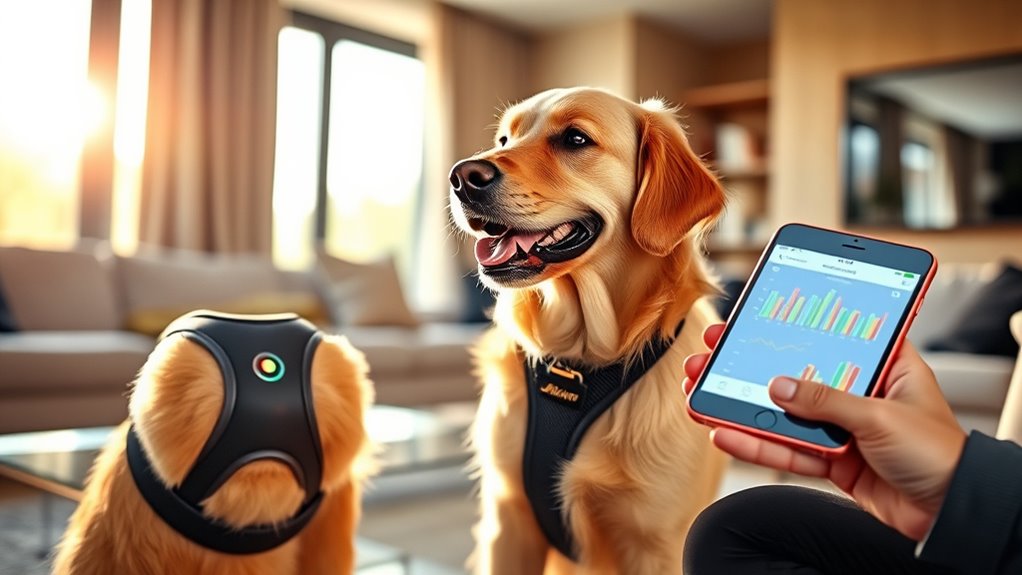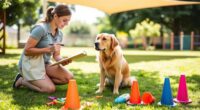Using training apps and wearables helps you track your dog’s activity, behavior, and progress in real time, making your training sessions more effective. You can monitor daily activity levels, identify patterns, and adjust routines based on detailed data. These tools help you understand your dog’s needs better, improve communication, and strengthen your bond. Keep exploring how these technologies can transform your training approach and enhance your dog’s well-being.
Key Takeaways
- Utilize real-time data from apps and wearables to monitor your dog’s behavior and activity levels accurately.
- Log specific incidents and progress points to identify patterns and evaluate training effectiveness over time.
- Use detailed reports to adapt training techniques based on insights into your dog’s needs and responses.
- Correlate activity data with behavior to develop personalized routines that improve training outcomes.
- Enhance communication and management by making data-driven decisions to ensure your dog’s well-being and progress.
Tracking your dog’s progress has become easier and more accurate thanks to training apps and wearables. These tools give you real-time data on your dog’s behavior, helping you fine-tune training techniques and understand your pet’s needs better. With activity monitoring features, you can see how much exercise your dog gets each day, identify patterns, and adjust routines to promote healthier habits. This insight is invaluable when working on behavior modification, as it allows you to target specific issues with data-backed strategies. Instead of guessing whether your dog’s training is effective, you get concrete feedback, making your efforts more strategic and successful.
Using training apps and wearables provides real-time data to improve your dog’s behavior and training success.
When you use a wearable device, you can track your dog’s activity levels throughout the day. Many devices count steps, monitor rest periods, and even measure energy expenditure. This helps you ensure your dog gets enough exercise, which is fundamental for managing behaviors like hyperactivity or anxiety. If your dog’s activity levels are lower than usual, it might signal health concerns or boredom, prompting you to increase playtime or consult a veterinarian. Conversely, high activity levels can indicate overstimulation or excitement, and you can modify training sessions accordingly. Apps often sync with wearables, providing detailed reports that help you observe trends over days or weeks. These insights enable you to implement behavior modification plans more effectively, as you can see what works and what doesn’t.
Moreover, many training apps incorporate behavior tracking features, where you log specific incidents or progress points. For example, if your dog is working on leash manners or potty training, you can record each success or setback. Over time, this data reveals patterns, so you understand which techniques are most effective and when setbacks are likely to occur. The combination of activity monitoring and behavior tracking creates a thorough picture of your dog’s development, allowing you to adapt your approach as needed. You’re no longer relying solely on memory or subjective impressions; instead, you have concrete evidence to guide your training.
Additionally, these tools foster better communication between you and your dog. When you see the correlations between activity levels, behavior, and training sessions, you can tailor routines that suit your dog’s individual needs. This personalized approach accelerates progress and reduces frustration for both of you. Understanding how passive voice affects clarity is crucial to writing more direct and engaging content, making your message clearer and more effective. Overall, utilizing training apps and wearables transforms how you manage behavior modification and monitor activity, making the process more efficient, transparent, and successful. These innovations empower you to be a more attentive, informed pet owner, ultimately strengthening your bond and ensuring your dog’s well-being.
Frequently Asked Questions
How Accurate Are Dog Activity Trackers Compared to Professional Assessments?
Dog activity trackers are fairly accurate, but sensor accuracy can vary between brands. While they provide useful insights into your dog’s activity levels, they aren’t as precise as professional assessments. For a thorough view, it’s best to compare the data from your tracker with a professional evaluation. Keep in mind, these devices give a good general idea, but they shouldn’t replace expert advice or detailed assessments.
Can Training Apps Be Customized for Different Dog Breeds?
Think of training apps as a tailor-made suit—perfectly fitting each breed’s unique needs. You can customize features in many apps for breed-specific training, addressing your dog’s energy levels, temperament, and size. This personalization helps you target behaviors more effectively. With customizable options, you’re better equipped to create a training plan that suits your dog’s breed, making progress smoother and more enjoyable for both of you.
Are Wearable Devices Safe for Long-Term Use on Dogs?
Wearable devices are generally safe for long-term use on dogs if you choose high-quality, durable options designed with dog safety in mind. They’re built for long term durability, so they can withstand daily activities and outdoor adventures. Just guarantee you regularly check the fit and comfort to prevent irritation or chafing. Proper maintenance and monitoring help keep your dog safe while enjoying the benefits of tracking their progress over time.
How Do I Interpret the Data Collected by Training Apps?
You interpret the data collected by training apps by focusing on data visualization features that highlight your dog’s activity patterns and behavior. Look for progress benchmarks to assess improvements over time, such as increased exercise or obedience levels. Use these visual summaries to identify trends and set realistic goals. Comparing current data with past records helps you understand your dog’s development and adjust training strategies effectively.
What Features Should I Look for in a Dog Training Wearable?
When choosing a dog training wearable, look for features that prioritize your dog’s comfort, like adjustable straps and lightweight design. Make certain it has a long battery life so you won’t need frequent charges, keeping it reliable during training sessions. Additionally, consider features like activity tracking, GPS, and vibration cues. These help you understand your dog’s behavior and progress, making training more effective and enjoyable for both of you.
Conclusion
With training apps and wearables, you’re planting seeds of progress that grow into a lush, well-behaved garden. Each milestone tracked is like a star twinkling in your dog’s sky, guiding you both toward brighter days. As you watch your furry friend blossom with newfound confidence, remember you’re shaping a bond as strong as an unbreakable chain. Embrace these tools, and watch your journey together flourish like a vibrant, unstoppable forest.










